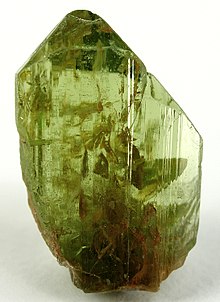| Peridot | |
|---|---|
 | |
| General | |
| Category | Silicate minerals |
| Formula (repeating unit) | (Mg,Fe)2SiO4 |
| Crystal system | Orthorhombic |
| Identification | |
| Color | Yellow, to yellow-green, olive-green, to brownish, sometimes a lime green, to emerald hue |
| Twinning | Uncommon, simple twinning can occur on {100}, {011},{012}, cyclic twinning on {031} |
| Cleavage | Poor on {010} and {110}, {010} cleavage improves with increasing iron content |
| Fracture | Conchoidal |
| Mohs scale hardness | 6.5–7 |
| Luster | Vitreous to oily |
| Streak | Colorless |
| Diaphaneity | Translucent to transparent |
| Specific gravity | 3.2–4.3 |
| Refractive index | 1.64–1.70 |
| Birefringence | +0.036 |
| Pleochroism | Weak pale yellow-green to yellow, yellow to yellow orange |
| Melting point | between 1,200 and 1,900°C |
| Fusibility | Infusible avoid thermal shock |
| Solubility | Slowly forms gelatinous silica in H Cl |
Peridot (/ˈpɛrɪˌdɒt, -ˌdoʊ/ PERR-ih-dot, -doh), sometimes called chrysolite, is a yellow-green transparent variety of olivine. Peridot is one of the few gemstones that occur in only one color.
Peridot can be found in mafic and ultramafic rocks occurring in lava and peridotite xenoliths of the mantle. The gem occurs in silica-deficient rocks such as volcanic basalt and pallasitic meteorites. Along with diamonds, peridot is one of only two gems observed to be formed not in Earth's crust, but in the molten rock of the upper mantle.[1] Gem-quality peridot is rare on Earth's surface due to its susceptibility to alteration during its movement from deep within the mantle and weathering at the surface.[2] Peridot has a chemical formula of (Mg,Fe)2SiO4.
Peridot is one of the birthstones for the month of August.[3]
- ^ "Peridot crystals: Formation & locations". Rock & Gem Magazine. 10 July 2023. Retrieved 21 January 2024 – via rockngem.com.
Get to know this August birthstone
- ^ "Peridot". Gem notes. geo.utexas.edu. Geology Department. Austin, TX: The University of Texas. course 347k. Retrieved 2024-01-21.
- ^ "Color, meanings, and symbolism [of] August birthstone peridot". Old Farmer's Almanac – via almanac.com.